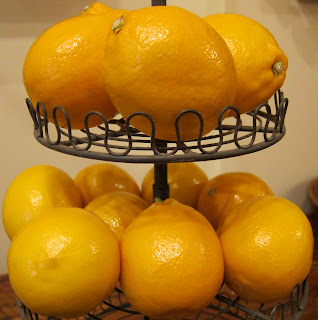Monday, April 26, 2010
Sunday, April 25, 2010

Elephants Delicatessen, Portland, OR
1/2 cup onion, diced
1/2 cup unsalted butter
2 - (14-1/2) ounce cans diced tomatoes
1 teaspoon salt
1/2 teaspoon black pepper
1/4 teaspoon baking soda
1/2 teaspoon dried Thyme
1 cup fresh orange juice
1/2 cup heavy cream
In a large saucepan saute diced onion in melted butter until tender. Add tomatoes, salt, pepper, baking soda and dried thyme. Bring to a boil then turn heat down to simmer uncovered for approximately 15 minutes or until slightly thickened.
Transfer the tomato mixture to a food processor and puree until smooth; strain the liquid discarding the solids and return mixture to the saucepan. Add the fresh juice and cream; bring to a simmer stirring constantly and serve.
Saturday, April 24, 2010
 Meyer Lemon Marmalade
Meyer Lemon Marmalade- 8 Meyer lemons
- 10 cups water
- 8 cups sugar
- Rinse the lemons and wipe them dry. Slice off the stem ends, then halve them and remove the seeds with the tip of a paring knife. Reserve the seeds. Cut each lemon piece in half again, then slice very thinly (a mandoline works well for this.
- Take all reserved seeds and place them on a piece of cheesecloth. Tie the cheesecloth shut with twine, forming a small bag of the seeds.
- Place the lemon slices in a heavy nonreactive 8-qt pot. Add the water and the cheesecloth bag of seeds. Cover and let sit overnight.
- After 18-24 hours, stir the sugar into the lemon-water and set the pot over high heat. Bring to a boil, stir, then reduce heat to low to maintain a gentle simmer. Stir occasionally to make sure the lemon slices are not sticking to the bottom of the pot and burning. If any white foam rises to the top, skim it off.
- Continue cooking the mixture until it reaches the jelling point – 220 degrees Fahrenheit. This will take at least one hour. Once you reach this point, take the pot off the heat. To check if your marmalade is properly jelled, place a small amount on a plate and stick it in the freezer. After five minutes, remove the plate from the freezer and nudge the jell; if it wrinkles, it's finished. If it's still runny, return the pot to the heat, checking every few minutes to see if it's done.
- Once the marmalade has reached the jell stage, remove it from the heat, remove the cheesecloth bag of seeds, and ladle into clean jars. Refrigerate, tightly covered, and it'll keep for a while. Makes about 2 quarts.
Wednesday, April 21, 2010
1 quart lemonade
1 cup cran-raspberry juice
1 pint blueberries
1 pint raspberries
1½ cups 7-Up
Combine lemonade, cran-raspberry juice, blueberries and raspberries in a large pitcher, and stir well. Cover and refrigerate at least 2 hours. Just before serving, add 7-Up. Makes 8 servings.
Tuesday, April 20, 2010
Morning Glory Muffins
with Blackberries
Makes 15 muffins
2 cups all-purpose flour
1 1/4 cups sugar
2 teaspoons baking soda
2 teaspoons ground cinnamon
1/2 teaspoon coarse salt
2 cups coarsely grated carrot
1/2 cup sweetened shredded coconut
1 tart apple, peeled, cored and grated
3 large eggs
1/2 cup canola oil
3/4 cup applesauce, plain, unsweetened
1 teaspoon vanilla extract
2/3 cup frozen blackberries
Preheat oven to 350 degrees. Grease or line muffin tins. Measure flour, sugar, baking soda, cinnamon and salt into large bowl. Stir in carrots, coconut and apple. In another bowl, whisk together eggs, oil, applesauce and vanilla and pour into flour mixture, mixing well. Gently stir in berries.
Fill muffin cups to top and bake for 25 minutes or until a cake-tester inserted in center comes out clean. Let muffins cool for five minutes, then turn out onto a rack.
from "The Berry Bible"
Monday, April 19, 2010
Miss Emmy Lou’s Chicken & Rice Salad
Note: I like to use romaine leaves because they look pretty but you can also use an organic spring mix and mound the salad on top.
1 6-ounce box long grain and wild rice mix
1 cup chicken broth
1 cup coarsely chopped pecans
3 cups chopped cooked chicken
1 red pepper, chopped
3//4 cup chopped arugula
1/4 cup chopped green onion
1 1/2 tablespoons soy sauce
2 tablespoons rice wine vinegar
1 1/2 tablespoons sesame oil
1/4 teaspoon salt
1/4 teaspoon pepper
Lettuce leaves (see note)
- Prepare the rice according to directions on the package, substituting 1 cup chicken broth for 1 cup of water.
- Toast the chopped pecans in a shallow pan in a 350 degree oven for 5 to 10 minutes, stirring occasionally.
- In a large bowl, combine rice, chicken, pecans, red pepper, arugula and green onion.
- Whisk together soy sauce, rice wine vinegar, sesame oil, salt and pepper. Pour over chicken mixture, tossing lightly. Line individual plates with lettuce and serve salad on top.
Yield: 4 servings
Frosted Bellinis
1 (750 milliliter) bottle of champagne
2 (11.5 ounce) cans peach nectar
1/2 cup peach schnapps
Combine all ingredients in a large pitcher, stirring until well mixed. Serve immediately in chilled glasses over crushed ice.
Yield: 6 servings
Sunday, April 18, 2010
Wednesday, April 14, 2010
Risotto with lettuce and spring onion
This is known as Risotto con le Cipolline e la Lattuga in Italy
8 spring onions, chopped finely
3 tbsp unsalted butter
340g/12oz arborio rice
1 small glass white wine
up to 2 litres/3½ pints chicken or vegetable stock, kept hot
1 head round lettuce, washed and dried, then shredded coarsely
sea salt and freshly ground black pepper
4 tbsp freshly grated parmigiano reggiano
1. Fry the spring onions very gently and slowly with half the butter. When they are soft, add the rice and quickly toast the grains thoroughly all over.
2. When the rice is crackling dry, add the wine and stir, evaporating the fumes. Then start to add the stock, beginning with 3 ladles so as to completely submerge the rice.
3. Stir thoroughly, and allow the liquid to be absorbed, then lower the heat and continue to add stock in quantities of 1-2 ladles at a time and stir constantly between each addition.
4. The rice itself will let you know when it needs more liquid by allowing a clear wake to open up behind the spoon as you draw it across the pan.
5. After about 20 minutes, the rice should have swelled and become creamy, but the grains should still be chewy, but not chalky. In no way should there be any hint of rice pudding about it.
6. Take it off the heat, stir in the lettuce and stir it around to wilt the leaves, then add the remaining butter, adjust the seasoning and stir in the parmigiano. Cover and leave to rest for about 4 minutes, then transfer on to a warmed serving dish or individual plates and eat at once.
Tuesday, April 13, 2010

Claudia's Pennewith pesto, new potatoes, and pine nuts |
| 1/2 | cup pine nuts |
| 2 | cups tightly packed fresh basil leaves |
| 2 | cloves garlic |
| 1/4 | teaspoon salt, or to taste |
| 1/2 | cup olive oil |
| 1/4 | cup freshly grated Parmesan cheese |
| 1/4 | cup freshly grated pecorino cheese |
| 1/2 | pound slender green beans, cut into 2-inch pieces |
| 5 | tiny red or yellow new potatoes, halved if large |
| 1 | pound penne |
| Pepper, to taste |
2. In a food processor, combine the basil leaves, garlic, 1/4 teaspoon salt, and pine nuts. Pulse the mixture until it is finely chopped. With the machine running, add the olive oil through the feed tube in a thin steady stream until the mixture forms a paste. Use a rubber spatula to transfer the pesto to a bowl. Stir in the Parmesan and pecorino cheeses.
3. Bring a large saucepan of salted water to a boil. Add the green beans and cook them for 3 minutes or until they are bright green and tender but crisp. Use a slotted spoon to remove the beans from the water.
4. Add potatoes to the same water and simmer for 5 minutes or until they are tender when pierced with a skewer. Use the slotted spoon to remove the potatoes from the liquid. Leave to cool slightly, then slice the potatoes thickly.
5. Bring the vegetable cooking water back to a boil. Add the penne and cook over high heat for 12 minutes or until tender.
6. Before draining the pasta, remove 2 tablespoons cooking water.
7. Drain the pasta into a colander. Shake the colander to remove the excess moisture and tip the penne into a bowl. Add the pasta cooking water and the pesto. Toss the mixture gently to coat the pasta all over.
8. Add the green beans, potatoes, and pepper. Taste for seasoning and add more salt and pepper, if you like.
Thursday, April 1, 2010
Ingredients
1 free-range egg
50g/1¾oz fresh chives
4 thin, square slices pumpernickel or rye bread
50g/1¾oz cream cheese
300g/10½oz smoked or cured salmon, finely sliced
50g/1¾oz salmon roe (optional)
1 lemon, quartered, to serve
Method
1. Boil the egg in simmering water in a pan for eight minutes, drain and cool under cold running water.
2. Reserve four whole chives for decoration and, with a pair of scissors, finely snip the chives and arrange on a flat plate.
3. Spread the bread with the cream cheese, right to the edges.
4. Lay the bread cheese-side down on the chives, pressing lightly, until each slice is completely covered with a fine layer of chives. It should look like a green carpet.
5. Peel the egg and finely slice in an egg-slicer or a sharp knife.
6. Top the slices of bread with a fold of salmon, a slice of egg, and a teaspoonful of salmon roe, if using.
7. Decorate with a whole chive, and serve with a wedge of lemon.










